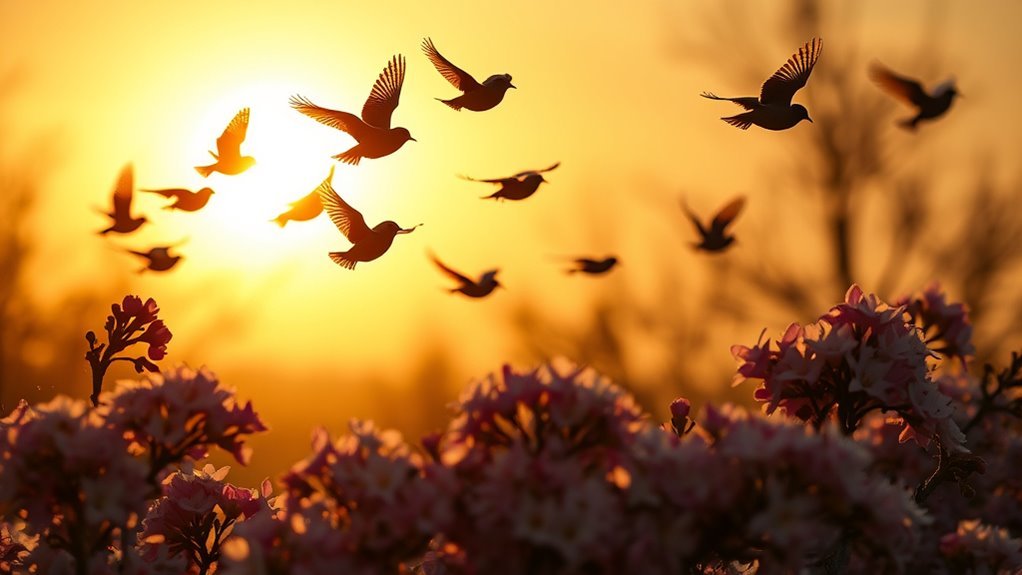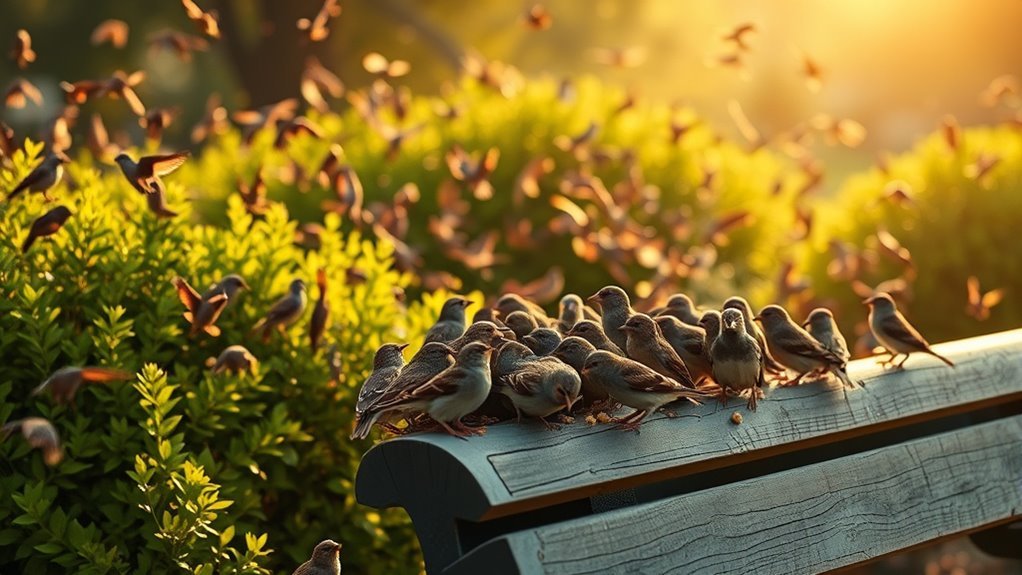Sparrow Birds: Their Meaning and Significance Explained
Sparrows hold significant symbolism in many cultures. They often represent hope and joy in daily life. These small birds show resilience and adapt well to their surroundings. When we look closer at their behaviors, we can see themes of connection and support. These traits can teach us about our own relationships and experiences, offering valuable insights that may surprise us.
Key Takeaways
- Sparrows symbolize hope and joy, embodying resilience during tough times and encouraging a positive outlook on life.
- In various cultures, sparrows represent freedom, community, and sustainability, acting as messengers of hope in myths and stories.
- Their ability to adapt to different environments and their flexible nesting choices highlight their resilience and survival skills.
- Sparrows exhibit strong community bonds through flocking behavior, showcasing the importance of belonging and teamwork in nature.
- In literature and art, sparrows signify themes of vulnerability and strength, embodying the beauty of simple moments and societal connections.
The Symbolism of Hope and Joy

Sparrow birds can bring a sense of hope and joy. They symbolize resilience in difficult times, a message strong in many cultures.
Observing their cheerful and social behavior shows how they connect with each other. This connection reflects the joy we experience in our own communities. Sparrows remind us that life flourishes when we support one another.
Their chirping and fluttering encourage us to focus on the positive side of life, even during tough moments. Ultimately, sparrows inspire us to nurture hope and joy.
They connect nature and our human experiences, fostering shared moments that unite us.
Resilience and Survival in Nature
Sparrow birds show strong resilience and survival skills in nature. They can adapt to different environments, including urban areas and forests.
Sparrows build nests in various locations, which demonstrates their flexibility. They change their feeding habits to make use of available food, such as seeds, insects, and human food scraps. This ability helps sparrows thrive despite challenges like climate changes and habitat loss.
They also form groups, which offers safety and improves their foraging success. By observing sparrows, we learn how life can face difficulties. Their determination reflects our own struggles and victories.
Sparrows inspire us to feel connected to a resilient community in nature.
Cultural Significance Across Different Societies

Sparrows hold special meaning in many cultures. They symbolize freedom, community, and sustainability. In various myths, sparrows serve as messengers of hope and resilience. For instance, in some Asian cultures, they represent love and loyalty.
Often, folklore depicts them as companions of gods or spirits. In rural areas, sparrows create a feeling of belonging, reminding people of their connections to one another. Stories about sparrows overcoming challenges resonate with shared human experiences.
This reinforces bonds within communities. Overall, sparrows act as symbols across cultures, highlighting the truths of unity and survival. You can appreciate these themes in your own community.
Sparrows in Literature and Art
Sparrows appear in many literary and artistic works. They symbolize both vulnerability and strength. Sparrows represent community and the daily challenges of life. Their image evokes feelings and prompts reflection on human experiences.
Here are key points to consider:
- Sparrows in Poetry: Poets often use sparrows to show themes of loss and renewal.
- Sparrows in Painting: Artists display sparrows to highlight beauty in simple moments.
- Symbolism: Sparrows stand for freedom and the passage of time.
- Cultural Context: Many cultures see sparrows as messengers that connect to deeper truths in society.
Exploring these themes helps us see how sparrows relate to universal experiences, enhancing our sense of belonging.
Lessons of Community and Connection

Sparrows often represent important truths about human life, especially the value of community and connection. They show that belonging matters. You can see how they flock together, creating bonds that help them survive. This cooperation illustrates how relationships contribute to well-being.
Sparrows also build nests, showing their commitment to creating safe spaces. This highlights the need for nurturing connections. As they care for their young, they demonstrate teamwork and support. By adopting these qualities, you can create a sense of unity and shared identity in your life.
The Spiritual Meaning of Sparrow Encounters
Encountering a sparrow can hold significant spiritual meaning. Observing this bird may indicate that there's a valuable message for you to interpret.
Here are some key insights:
- Symbol of Freedom: Sparrows represent freedom. They encourage you to seek your own independence.
- Strength in Numbers: Sparrows often travel together. This highlights the importance of community and building connections with others.
- Nurturing Spirit: Sparrows embody kindness and care. They remind you to take care of yourself and to support those around you.
- Trust in Change: Sparrows migrate with the seasons. Their journey teaches you to embrace change and trust in life's transitions.
Reflecting on these messages can guide you in your spiritual journey.
Frequently Asked Questions
What Do Different Types of Sparrows Symbolize?
Different types of sparrows hold various meanings in different cultures. They often symbolize community, connection, and resilience. These birds remind us of the value of belonging and the strength found in unity. When you see a sparrow, think of togetherness and the support we get from one another. Their presence can inspire feelings of warmth and camaraderie among people.
How Do Sparrows Adapt to Urban Environments?
Sparrows adapt well to urban settings. They make their nests in buildings, eaves, and parks. These birds change how they find food. They often scavenge food that is easy to access near people. This ability to adjust helps them survive in cities filled with concrete and human activities. Their presence adds liveliness to urban areas, making them enjoyable for people who appreciate nature.
Are Sparrows Endangered or at Risk?
Sparrows are facing a decline in their population. Their numbers are decreasing due to habitat loss caused by urban development and farming practices. It is important to take action to protect these birds and ensure they can continue to live in our areas. Conservation efforts play a key role in helping sparrows thrive in our environment.
What Do Sparrows Eat in the Wild?
In the wild, sparrows eat seeds, fruits, and small insects. They show flexibility in their food choices based on what is available and the conditions around them. Observing sparrows can reveal how their diet changes with the seasons and environment. This adaptability helps them thrive in different habitats.
How Long Do Sparrows Typically Live?
Sparrows typically live for 3 to 5 years in the wild. Under ideal conditions, some can live as long as 13 years. Understanding these factors helps you appreciate their ability to survive and thrive in various environments.

Hello, I’m Emily Price, the founder of Birds Affection. As a passionate bird enthusiast and spiritual seeker, I’ve always been fascinated by the symbolic meanings and mystical connections between birds and our lives. On this website, I share my knowledge and insights on the spiritual significance of various bird species, exploring their roles as messengers, guides, and teachers. Through my writing, I aim to inspire and educate others on the profound wisdom and beauty that birds bring to our world. Join me on this journey as we delve into the enchanting realm of bird symbolism and discover the hidden meanings behind these magnificent creatures.







